Futaoki
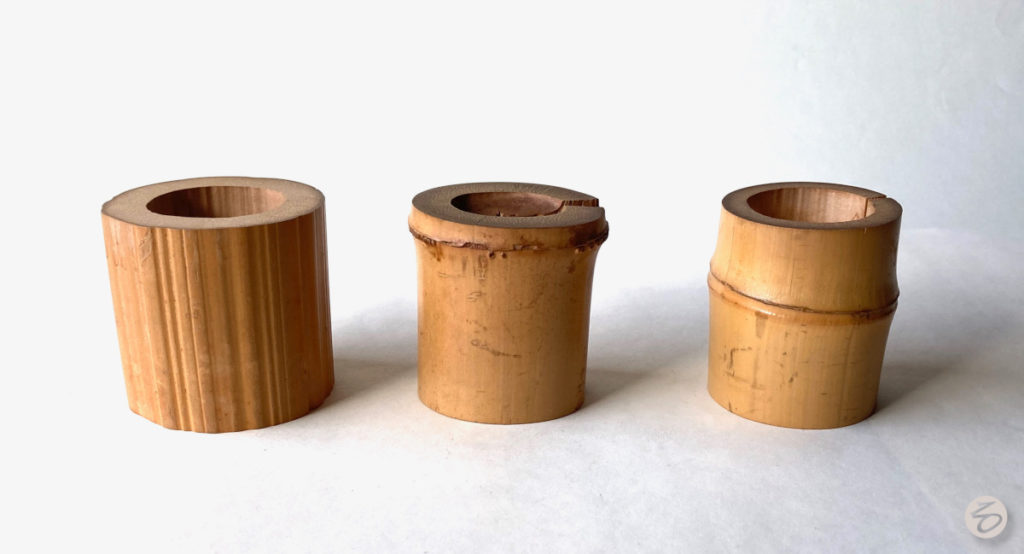
The height of Rikyū’s take futa-oki, 竹蓋置, bamboo lid-rest, measures 1.8 sun kane-jaku, 1.8 寸曲尺, “inch” bend-span: also 18 bu (分) kane-jaku, 180 rin (厘)kane-jaku. The 1.8 sun kane-jaku measurement equals 1.44 sun kujira-jaku. Ideally, the bamboo lidrest is made of freshly cut green bamboo: ao-dake, 青竹, green-bamboo, hiki-kiri, 引切, draw-cut (sawn), futa-oki.
Is the origin of the aodake futaoki a sakazuki made of aodake, and perhaps for drinking o-mi-ki , お神酒, hon.-sacred sake, at a Shintō ritual?
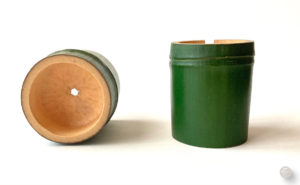
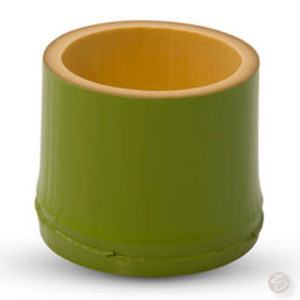
The green bamboo cup at the right, ao-dake sakazuki, 青竹盃, green-bamboo sake cup, h. 2” – 1.7 sun kane-jaku. The height of the green bamboo futaoki used by Take-no Jō-ō, 武野紹鴎, War-field Help-gull, Rikyū’s Tea teacher, was 1.7 sun kane. Later, Rikyū changed the height to 1.8 sun kane.
Sake can be stored in a chamber between two nodes of green bamboo that is closed so that the sake takes on the flavor of the bamboo. To open the container, a hole is made in the node of the bamboo so that the sake can be poured into cups. Is it possible that the hole in the sake cup is in keeping with the bamboo container? In Shintō rites, utensils are to be used once and discarded, so that the hole in the node of the futaoki is likened to the once-used omiki cup, which cannot be used again. If the aodake futaoki, upside down bamboo, was in theory used as a cup for drinking omiki, it brings to the Tea presentation some sacred Shintō spirit.
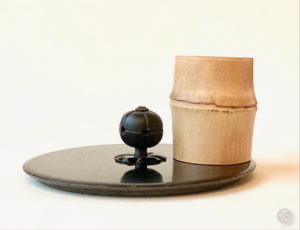
The top of the knob is the same as the lowest level of the bamboo node. Is this intentional?
The number 18 in its various manifestations is a very auspicious number in Japanese arts and science. The number 18 is symbolic of life. The Kanji for the number 18 is written jū–hachi, 十八, 10 8, ten-eight. These two Kanji may be written together to form the Kanji for ki and moku, 木, tree wood, etc., also means a living thing.
The size of Rikyū’s take futa-oki at 1.8 sun kane–jaku is emblematic and symbolic of life itself. Made of freshly-cut green bamboo, ao-dake, 青竹, the futa-oki is more or less still alive. Rikyū’s ao-dake hiki-kiri futa-oki is essential to the wabi nature of Chanoyu. The word wabi, 侘, means proud and lonely. In esthetics, wabi is the feeling observed when comparing the differences between new, refined, and aged, worn, irregular. Wabi is the contrast between two or more Tea utensils. For example, between a treasured tea container that is three hundred years old together and a freshly-cut green bamboo lid-rest.
The futa-oki is cut from bamboo so that the root end is upright, which makes the lidrest upside down when used. The bamboo futa-oki is also a rest for the bamboo hi-shaku, 柄杓, handle-ladle, used to dispense hot and cold water when making Tea. The cup, gō, 合, of the ladle has the root end at the bottom of the cup so that the cup is as the bamboo grows, the futa-oki is reversed so that the two pieces are opposite, complementary to each other – In and Yō, Yin and Yang. The cup holds water, the bamboo lid-rest has a hole in the fushi, 節, septum, so that it cannot hold water, and is therefore Yō.
Often, the hole has five, small radiating cuts that create a kind of star. There is some symbolism associated with this design, which could evoke any number of concepts. If the futaoki represents as aspect of immortality, is it related to the Go-rin, 五輪, Five-rings, and Go-gyō, 五行, Five-transitions? The hoya has five talons on the rim, but there are also hoya with six talons. The five elements and principles have wide reaching influence in Taoism.
There are three types of bamboo futa-oki – one for use with the fu-ro, 風炉, wind-hearth, and one for the ro, 炉, hearth, and one for both furo and ro. That for the furo has the fushi near the top of the futa-oki, and is called ten-bushi, 天節, heaven-node. The futa-oki for ro has the fushi near the middle of the bamboo, and is called naka-bushi, 中節, middle-node. One that can be used with both is the fushi-nashi, 節無し, node-no, that is a simple cylinder without the node, and is called a wa, 輪, circle, and fuki–nuki, 吹抜, blow-through.
The essential offerings in Buddhism are kō, ge, tō, 香華灯, incense, flower, light [candle]. One of the first actions when presenting the Gyō no gyō Dai-su Ten-mae, 行之行台子点前, Transition-’s-transition Stand-of Offer-fore, is to take the hoya kōro futaoki from the kensui and display it in front of the guests. The hoya represents the offering of incense.
The futaoki is identified with thunder in the Eki-kyō, 易経, Change-sutra, its cylindrical hollow form is called fuki-nuki, 吹抜, blow-though, so that the deity, Fū-jin, 風神, Wind-god, the companion of Rai-jin,雷神, Thunder-god, may be evoked. Fūjin holds a large drawstring bag that is filled with various winds, which are let loose when he opens the bag. Could the shifuku of the chaire be identified with the bag of Fūjin. The Thunder god Raijin is one of the five elemental gods in Taoism. Raijin is surrounded by a ring of eight small drums, Raijin holds in both hands a hammer that is called shō, 杵, that is identified with the vajra, the symbol of Hindu and Buddhist lightning of understanding. Fūjin and Raijin are subjects of Sen-ju Kan-non, 千手観音, Thousand-hand See-hear, and are also aspects of Taoist magic, Go-rai-hō, 五雷法, Five-thunder-law.
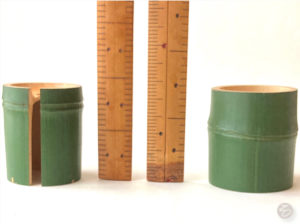
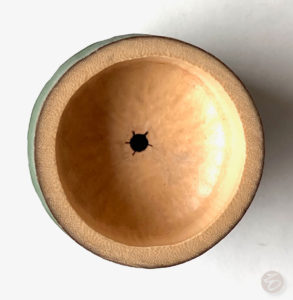
The shō-men, 正面, true-face, of a futa-oki is determined primarily by the position of the fushi. Because of the nature of bamboo, the fushi is often irregular around the circumference. The shōmen is where the fushi is at its lowest level. Perhaps the most obvious is with the naka-bushi. The lowest level of the fushi is where the measurement is established. The distance between the fushi and the bottom of the futa-oki should be one sun kane-jaku, so that the distance between the fushi and the top of the futa-oki is 8 bu kane-jaku.
The measurements themselves manifest the very nature of the relationship between 8 and 10. The numbers 8 and 10 are related to the concept of ya-ata, 八咫, eight-span, which is manifest in the Ya-ta-kagami, 八咫鏡, Eight-span Mirror, the sacred mirror of Shintō. Eight, 八, is the number of infinity in space, and Yata is symbolic of infinite vastness.
The location of the fushi on the ten-bushi futa-oki presents an unexpected relationship of measurements. Again, the height of the futa-oki is 1.8 sun kane-jaku. This kane-jaku measurement transposed to kujira-jaku is 1.44 sun kujira-jaku. Although there are a number of objects and circumstances identified with the number 1.44, but all are relatively obscure; an exception is twelve dozen making a gross. The distance between the fushi and bottom of the futa-oki is 1.44 sun kane-jaku. If the bamboo cracks and splits, the open split becomes the shōmen.
What, if any, is the significance of the five-point hole in the fushi of the futa-oki? The hole prevents the bamboo from containing water and is Yō, but why five tiny cuts around the small hole? One aspect of the kama, 釜, kettle, may have something that relates to the five-point hole. The ancient kama had a lid that had a tsumami, 摘み, pinch (knob), in the form of a hollow sphere created by two flowers with five-petals each. The flower appears to be ume, 梅, Japanese apricot. An additional flower is a kind of escutcheon for the post of the knob attached to the lid. Thus, there are three ume flowers that may have their own symbolism. The aspect is the five petals of the flowers compared to the five points of the hole in the bamboo futa-oki.
The hollow chamber of bamboo is called a kan, 稈, which applies to all hollow stems of plants.
The bud of the stem on the bamboo stalk that is located at the fushi is called a kuki no me, 茎の芽, stem’s bud. At times this bud may be included in the futa-oki, chasen, and other bamboo objects. The same may be identified with indentation groove on the bamboo stalk where a branch would grow is called the hi, 樋, trough. This groove is an important aspect with regard to the chashaku. There is only one hi / trough at a fushi, and they are on alternate sides of the “stalk.”
The reason that bamboo is used may be because it has nodes called fushi, 節, which may be that it is wordplay on fu-shi, 不死, no-death, immortality. The bamboo futaoki is upside down as it may be emptying its treasured contents.
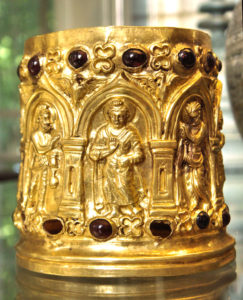
Seemingly utterly out of the realm of Chanoyu, there are objects that may be related in curious ways, as it has imagery of the Buddha. The Bimaran casket in the British Museum may be such an object. The Bimaran casket or Bimaran reliquary is a small gold reliquary for Buddhist relics that was found inside the stupa no.2 at Bimaran, near Jalalabad in eastern Afghanistan. It was contained in a steatite stone reliquary along with some small gem-like stones, identified as being of the Buddha, and coins. Made in the first century AD, the height of the cylindrical piece is H. 6.7 x 6.6 cm, transposed to 1.8 sun kujira-jaku, the size of a Rikyū-gata chū-natsume.
The exterior is decorated with eight repousse image of standing Buddhist deities in pointed arches: two identical groups of Brahman-Buddha-Indra, and two devotees or Bodhisattvas in-between, and two rows of rubies from Badakhshan. The circular bottom is a relief design of an eight-petal flower [lotus?].
